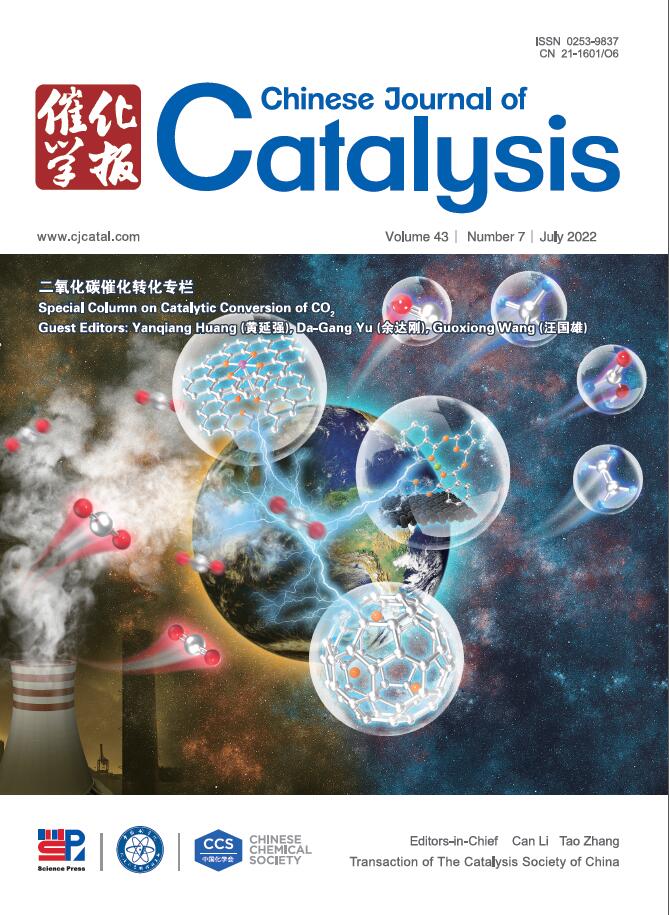Ultra-low doping 0.1(PtMnFeCoNi)/TiO2 catalysts: Modulating the electronic states of active metal sites to enhance CO oxidation through high entropy strategy
IF 17.7
1区 化学
Q1 CHEMISTRY, APPLIED
引用次数: 0
Abstract
The catalyst cost is a key factor limiting the CO purification of sintering flue gas. Here, an ultra-low-loading high-entropy catalyst was prepared by simple calcination process. By anchoring multiple active metal sites in the stable anatase TiO2 phase, it shows efficient CO catalytic oxidation activity. The metal components (Pt, Mn, Fe, Co, Ni) were uniformly dispersed on the surface of TiO2 in the form of high-entropy compounds and undergo strong metal and support interaction with TiO2. The results showed that 0.1(PtMnFeCoNi)/TiO2 achieved complete oxidation of CO at 230 °C, and its catalytic oxidation ability was significantly better than that of the corresponding monometallic and bimetallic catalysts. The high-entropy component adjusts the electronic environment between the TiO2 support and the metal to promote the reduction of the Ti3d band gap, enhances the electron-induced ability of the catalytic system to gas molecules (CO and O2), and exhibits excellent resistance to SO2 and H2O. The work is of great significance to understand the synergistic regulation of catalyst activity by multiple metal at the atomic level and provides a strategy for effectively reducing the content of precious metals in the catalyst.
超低掺杂0.1(PtMnFeCoNi)/TiO2催化剂:通过高熵策略调节活性金属位的电子态以增强CO氧化
催化剂成本是制约烧结烟气CO净化的关键因素。本文采用简单煅烧法制备了一种超低负荷高熵催化剂。通过在稳定的锐钛矿TiO2相中锚定多个活性金属位,表现出高效的CO催化氧化活性。金属组分(Pt, Mn, Fe, Co, Ni)以高熵化合物的形式均匀分布在TiO2表面,并与TiO2发生强烈的金属和载体相互作用。结果表明,0.1(PtMnFeCoNi)/TiO2在230℃下实现了对CO的完全氧化,其催化氧化能力明显优于相应的单金属和双金属催化剂。高熵组分调节了TiO2载体与金属之间的电子环境,促进Ti3d带隙的缩小,增强了催化体系对气体分子(CO和O2)的电子诱导能力,并表现出优异的抗SO2和H2O性能。这项工作对于在原子水平上了解多种金属对催化剂活性的协同调节具有重要意义,并为有效降低催化剂中贵金属含量提供了策略。
本文章由计算机程序翻译,如有差异,请以英文原文为准。
求助全文
约1分钟内获得全文
求助全文
来源期刊

Chinese Journal of Catalysis
工程技术-工程:化工
CiteScore
25.80
自引率
10.30%
发文量
235
审稿时长
1.2 months
期刊介绍:
The journal covers a broad scope, encompassing new trends in catalysis for applications in energy production, environmental protection, and the preparation of materials, petroleum chemicals, and fine chemicals. It explores the scientific foundation for preparing and activating catalysts of commercial interest, emphasizing representative models.The focus includes spectroscopic methods for structural characterization, especially in situ techniques, as well as new theoretical methods with practical impact in catalysis and catalytic reactions.The journal delves into the relationship between homogeneous and heterogeneous catalysis and includes theoretical studies on the structure and reactivity of catalysts.Additionally, contributions on photocatalysis, biocatalysis, surface science, and catalysis-related chemical kinetics are welcomed.
 求助内容:
求助内容: 应助结果提醒方式:
应助结果提醒方式:


